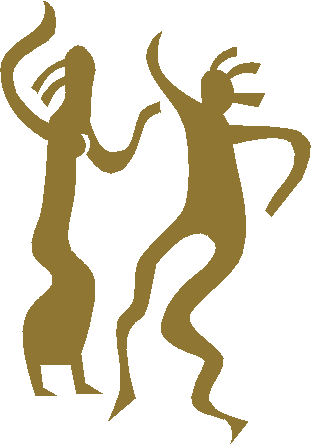You are here: Victoria's
Dance Secrets > ABCs of
Dance > Arm Positions
ARM
POSITIONS  Just like
the feet, the arms also form precise positions. However since arms figure mainly to
balance and enhance the styling of the dances, less rigid rules govern them in
ballroom dancing. Just like
the feet, the arms also form precise positions. However since arms figure mainly to
balance and enhance the styling of the dances, less rigid rules govern them in
ballroom dancing.
These arm positions
are based on the formal positions of ballet, but are not limited to ballet’s strict
technique.
In all arm positions,
the whole arm should be totally relaxed. Arms should be lifted by the elbow, using the
shoulder as a fulcrum, and should utilize the principle of force
points in every movement.
1st ARM
POSITION: ARMS EXTENDED
FORWARD, elbows out, forefingers touching, palms facing down. The shoulder should be
slightly higher than the elbow, which should be slightly higher than the wrist, which in
turn is slightly higher than the hand and fingers. This position is seldom used in
ballroom dancing. It's variation is to keep the hand close to the chest, bending at the
elbow, and used mainly for the lady’s independent multiple turns toward or away
from her partner.
2nd ARM
POSITION: ARMS EXTENDED TO THE
SIDE, elbows facing back, palms facing up or down. This position is used mainly to help
accelerate and ‘force’ multiple independent side turns by the lady. Also used in
such positions as the Shadow Position.
3rd ARM
POSITION: ONE ARM EXTENDED TO
THE SIDE; THE OTHER FORWARD. This combines the first and second arm positions.
4th ARM
POSITION: ONE ARM EXTENDED TO
THE SIDE; THE OTHER RAISED ABOVE THE HEAD. The raised hand should be straight but not
stiff, with palm either facing inside or outside. Fingers should be slightly together, all
facing the same direction.
5th ARM
POSITION: BOTH ARMS RAISED
ABOVE THE HEAD, palms facing inside or outside. The arms should be straight but totally
relaxed.
GRACEFUL
ARMS, HANDS AND FINGERS
Some
dancers style their arms to suit special dances, and veer away from the formal arm
positions such that they are not necessarily extended forward, sideward, or upward, but
diagonally side up or down. Feel free to try out various positions, but practice them in
front of the mirror to check how they look before using them in front of an
audience.
Amateur
dancers tend to flatten their palms and extend their fingers in all directions. This makes
the fingers look stiff and heavy. If you are the follower, try to keep the whole arm,
including the hand and fingers as relaxed as possible, and keep the fingers facing in one
direction.
Some
dancers loose control of their elbows and let them fall in a sharp angle. While this may
be part of individual styling, each dancer is advised to compare the suggested arm
positions with this styled position, and use which ever is more personally comfortable and
visually appealing in terms of overall effect.
Professional dancers keep their palms narrow and the fingers together, positioning the
thumb toward the palm and below the forefinger. This makes all the fingers point in one
direction. In a totally relaxed position, the middle finger is lower than the forefinger
and the ring finger. Try this and see the difference when you practice the arm
positions.
Fight the
urge to use strength in your hands and fingers. This only stiffens them and your arm,
which will only negate the controlled movements of the other parts of your body. Instead,
master the force points. Always relax your arms, hands and fingers even when they are
extended.
Whatever
arm position you decide to use for the different dances, remember to use the appropriate
force point to keep that ‘sharp’ and confident
look.

|
